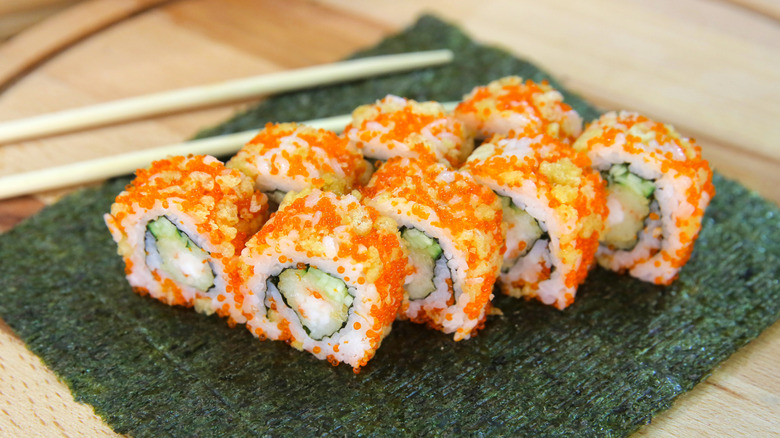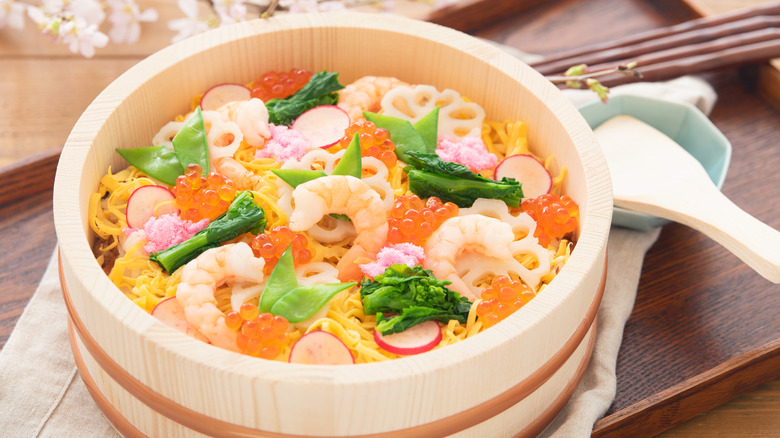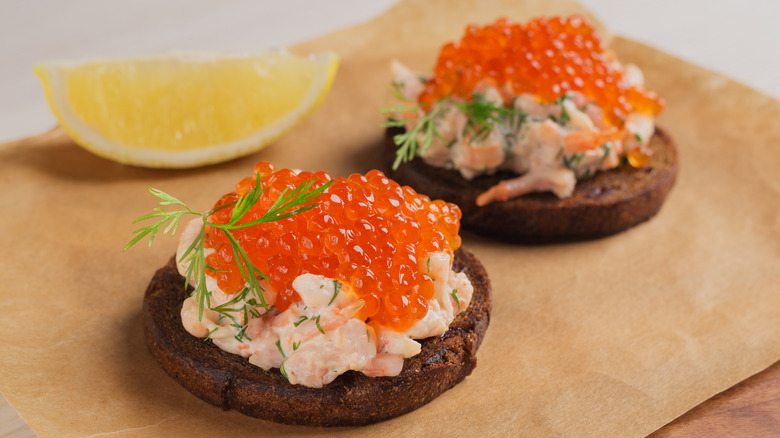What To Do If You Find Roe While Cleaning Shrimp
Whether it's used to make homemade ceviche or incredible shrimp summer rolls, there's no denying shrimp's impact on the food world. From street food stalls to fine dining establishments, this crustacean captivates cooks and diners alike with its delicious, succulent meat. Along with being a versatile and flavorful ingredient, some shrimp even gift chefs with an unexpected treasure. Cleaning out shrimp can be a mundane task, but if you're lucky, you may find a gel-like orange or pinkish substance hidden in the shellfish. Don't be alarmed by this mystery paste; it's called roe, or shrimp eggs, and it's more or less a luxury addition to your shrimp.
Roe is typically only found in shrimp that has been bought fresh and whole from a local seller, so you probably won't find any if you opt for frozen shrimp. Many types of sea creatures produce roe, and it is used for a vast array of culinary applications. For example, sturgeon roe is used to make traditional caviar, while sea urchin roe (or uni) is used in sushi. Shrimp roe is not necessarily considered as high-end as other varieties, but it is still a beloved ingredient in many cuisines. You are free to simply discard any roe you find while cleaning shrimp. However, it is recommended that you integrate it into your dish so you can indulge in the roe's rich, sweet flavor.
Basics of cooking with shrimp roe
Before you start cooking, you should probably confirm that you actually have shrimp roe on your hands. Depending on the type of shrimp, the eggs can be orange, pink, yellow, black, or even green in color. The roe should be clustered underneath the shrimp's outer carapace — along the stomach and between the legs. If the shrimp has what looks like roe anywhere else on its body, it could just be debris, so gently rinse the shrimp with water to wash away any non-edible bits. If you're unsure about whether or not you're dealing with shrimp roe, don't hesitate to ask your neighborhood fishmonger.
Once you're confident that you are indeed the proud owner of fresh shrimp roe, it's time to start cooking. You have a few options on how to handle the roe: You can gently separate it from the shrimp (which will require a steady hand to avoid rupturing the delicate eggs) or you can cook it along with the shrimp. If you choose the latter route and want to keep the roe attached to the shrimp, it helps to prepare a dish that requires as little damage to the crustacean as possible. That means cooking the shrimp whole and intact, and then peeling them right before you chow down.
Dishes with shrimp roe
The meals you throw together with shrimp roe can be as simple or as adventurous as you wish. If you want a straightforward snack that centers the briny, layered notes of the roe, try making an egg-heavy version of toast Skagen, or Swedish shrimp toast. Just toast a few slices of your favorite fresh bread, spread on a mixture of mayonnaise, mustard, and dill, then top with a spoonful of shrimp roe. Shrink the toast slices for an easy and unconventional hors d'oeuvre at your next dinner party. For a more filling recipe, add shrimp with roe to any seafood pasta dish, like shrimp scampi or seafood risotto.
Basically, shrimp roe can be added to anything that would benefit from an extra punch of the ocean. Not to mention, roe's vibrant color and extraordinary appearance make it an excellent garnish that'll bring a touch of elegance to any dish. Initially, finding roe in fresh shrimp may be off-putting, but the eggs are a delicacy worth exploring. From scrambled eggs to appetizers, shrimp roe is sure to bring a bonus bit of class to your cooking.


